
trust my inner self to make decisions as to how to make a mark and what colors to use.
I think I am dipping down into this subconscious or collective unconscious.”
cover Americana, 1987 | Mixed media construction, found objects above
Wives of Fisherman, 1948
Reproduction
Images courtesy of the Marianna Kistler Beach Museum of Art, Kansas State University

“I am sometimes (usually) on autopilot and
ROBERT BLUNK
ROBERT BLUNK
SEPTEMBER 20 through OCTOBER 29
2023
curated by JAY NELSON
A very special thank you to Robert & Diane Blunk, Judd Blunk, Scott Blunk, and Chad Graff & Joann Falkenburg for supporting the creation of this exhibition.

ROBERT BLUNK
by Jay Nelson, Guest Curator
Robert Blunk is the consummate artist. He is driven by curiosity and fascinated by the unlimited possibilities for depicting and interpreting a limited subject matter. He has not been motivated by financial gain or any critic’s opinion, but rather his artwork is a result of his seemingly insatiable desire and great joy in exploring a few subjects thoroughly. This selective focus on subject matter is not a veiled criticism of Robert’s oeuvre or his intellect. After all, Monet painted the haystacks 25 times and the waterlilies 250 times.
This exhibition, therefore, focuses on the subject matter that has held Robert’s interest from the time he was an undergraduate at the Kansas City Art Institute, in 1948-1950. An ongoing example of this recurring imagery is the “Three Fish” motif. The fish are non-specific as to their species and are generally arranged in a row like the Roman numeral III. They are executed in a number of media, including sketches, lithographs, and in various painting mediums. Robert’s experiments with the fish motif explore the basic artistic elements of color and value, form, line, shape, space and texture. In this way, we can define what Robert did as abstract art.

To clarify, the term “abstract” art is often used as a synonym for nonobjective art, but strictly speaking, abstract art takes an external reality as its subject, but transforms the subject into an image which communicates an inner reality—the way the artist sees the object, or just as often, how the artist feels about it.
Using this sense of the word abstract, Robert Blunk’s artwork is more in the stylistic camp of American modernism. This is not surprising since Robert came of age when this artistic style was predominant. Other practitioners of modernism are even cited by Robert as stylistic influences—Marsden Hartley,
Three White Fish, 1968 | Oil
Image courtesy of Marianna Kistler Beach Museum of Art, Kansas State University
John Marin, and Paul Klee. Not to confine Robert’s influences too narrowly, he also has quoted Van Gogh, who wrote in a letter to his brother Theo regarding the famous bedroom painting,
“This time it is just simply my bedroom, only here colour is to do everything, and giving by its simplification a grander style to things, is to be suggestive of rest or sleep in general.”
Looking around in this gallery, one can certainly see how Robert has put this principle to good use.
Indeed, like Van Gogh, another of Robert’s frequent motifs is the interior. Many of those early drawings from his Kansas City Art Institute sketchbooks are of interiors. It’s interesting to note that in these early sketches these fishes appear frequently, and even at that early date, there are often three of them. To this day, he frequently paints his own kitchen, in particular.
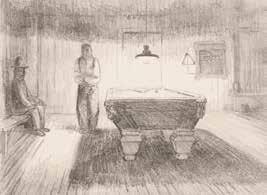
Another interior that Robert has treated in many works is a pool parlor called the Independence Avenue Recreation Hall. Some of his depictions include people seated at a table playing dominoes. These could well have been developed into artworks suggestive of the Regionalists’ subjects, common people doing ordinary things. Even though this art movement included such Midwest worthies as Thomas Hart Benton and John Steuart Curry, Robert went another direction. Gradually, that pool table is disassociated with both the players and the domino tables. His interiors remained unpopulated for the most part throughout his career, except for resident house cats.
Robert’s interiors primarily reflect his fascination with the mundane. Ordinary things, such as a kitchen table, seem to have been transformed into animals moving with curved legs. Coffee cups seem engaged in conversation. In reference to this tendency toward painting the ordinary, Robert, in his publication, Blunk @ 97 , quotes a favorite author of his, Brewster Ghiselin, on the subject of the creative process—
“Every new and good thing is liable to seem eccentric and perhaps dangerous at first glimpse, perhaps more than what is really eccentric, really irrelevant to life. And therefore we must always listen to the voice of eccentricity, within ourselves and in the world. The alien, the dangerous, like the negligible near thing, may seem irrelevant to purpose and yet be the call to our own fruitful development.”
Independence Hall Recreation Parlor, 1948 | Lithograph Image courtesy of Marianna Kistler Beach Museum of Art, Kansas State University
Perhaps this quote is at the center of Robert’s title for the show, Found Along the Shore.
It is worthy of remark that in this exhibit there are two interiors which have opened up as if they were folded paper, gables becoming simple triangles to reveal the sky above, with walls open to reveal the furnishings within. These two paintings, White Room with Lady and Cat and Rachel and the Angels seem to acquire a kind of mystic significance, rather than the rollicking playfulness evinced by the gamboling furniture in most of Robert’s interiors.

Another way in which Robert differed from the Regionalists of his era was that he did not paint naturalistic landscapes. Again referring back to the early KCAI sketchbooks, Robert did paint some landscapes, but they all look as if they might well have been plein air studies done for classes in that subject. He painted a few local scenes in his teaching years, but given their relatively ordinary, expected style, they were probably occasioned by requests from locals or perhaps they were ones he did as demonstration pieces for classes he taught.
More commonly, and in the spirit and style of Marsden Hartley, Robert painted the Maine coast. These are landscapes in a sense, but they are very stylized, and not at all naturalistic. They are often populated by fishermen, women hanging laundry or feeding chickens, boats and fish in the water, or other such “negligible near things.” The skyline often depicts a curved-earth horizon line with cigar shaped clouds floating above. The colors are vividly unrealistic and objects sometimes float in the compositional space.
This non-gravitational arrangement of objects, which appears in the coastal Maine landscapes and also in his interiors, has a precedent not only in Paul Klee’s work (who you’ll remember Robert cited as an influence) but also has a precedent in indigenous Plains tribes’ hide paintings, which also fascinate
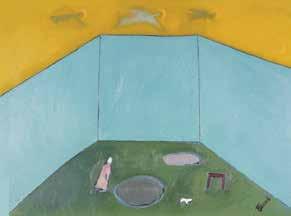 Rachel and the Angels, 1982 | Oil Image courtesy of Spencer Museum of Art, University of Kansas
White Room with Lady and Cat, 2019 | Enamel Image courtesy of Chad Graff & Joann Falkenburg
Rachel and the Angels, 1982 | Oil Image courtesy of Spencer Museum of Art, University of Kansas
White Room with Lady and Cat, 2019 | Enamel Image courtesy of Chad Graff & Joann Falkenburg
Robert. In Blunk @ 97 there is even a photograph of Robert wearing a self-made “roach,” a native headdress that is fashioned to resemble the mane of a horse. His sculpture, Boy with a Boat sports a similar mohawk. The boy is wearing a striped shirt similar to the 1948 lithograph, Big Fisherman. The boat that he holds echoes yet another of Robert’s recurring subjects.

Boats are certainly a significant presence in his paintings. They are present, as one would expect, in a few of the coastal Maine paintings, but more mysteriously, the boat is a central image in what he refers to as the “northern latitude” paintings. Only one example of this subject, Far North, is included in our exhibition, but the boat is depicted iconically as a crescent shape in an oval pool of water located in a starkly featureless landscape. All the visual elements suggest the remoteness of the place. Adding to the feeling of latent danger, there appear to be three threatening sharks in the swirling water surrounding the boat, so there is quite an uneasy edge to the image.
The largest painting in our exhibition is the diptych titled, Beached Boats. It is the most sizable painting in all of Robert’s body of work. You might also notice a sailing vessel in some of his 21st century collage pieces, to wit, Sail Boat and Fish, and Pink Hulled Boat where the boat is depicted with a swatch of a pink bath towel. One finds the boat shape in some of the more abstracted work as well, such as the recent Etaoin Shrdlu and in the 1958 non-objective painting, Shapes II
While the boat is a relatively significant shape in paintings and sketches, the boat is most supremely important as a subject and shape in Robert’s sculptures.
Shapes II, 1958 | Oil
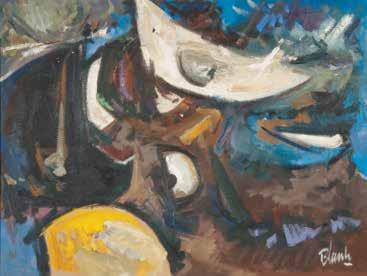 Bob in his self-made “roach”
Photo by Patrick Lofthouse
Image courtesy of Marianna Kistler Beach Museum of Art, Kansas State University
Bob in his self-made “roach”
Photo by Patrick Lofthouse
Image courtesy of Marianna Kistler Beach Museum of Art, Kansas State University
A prime example of Robert’s boat sculptures is The Becca Tamar Out of Boston Mass. It is typical of his welded metal works in that it is comprised totally of found objects and steel rod, some of which are recognizable, such as the blue pulley at the aft end of the boat, and some of which are metal sheeting with paint as it was found or as added by the artist. This ark of a boat is in honor of Robert’s daughter, who died prematurely at the age of 60. Her life was in the arts, like her father. She was the executive director of the New England Foundation for the Arts located in Boston. I believe this boat symbolizes the soul’s journey. There are other welded metal boat sculptures, one of which is titled Ship of Fools. He addressed the subject of the ship of fools several times, but the most significant example of this theme is now in the collection of The 6th Floor Project, a non-profit arts organization in McCook, Nebraska, founded by Chad Graff and Joann Falkenburg. Ship of Fools is mounted on the edge of ArtBank McCook, a new museum-like space in a repurposed brutalist building dedicated to the memory of Robert Blunk and John Thein, two extraordinary artists of the Great Plains. Chad and Joann, not coincidentally, are the conservators of Robert’s artworks that are not in other museum collections.

Robert used a medium that I think is fairly unique to him for making a number of other boat sculptures. That material is extruded clay. Robert had access to a ceramic factory producing clay pipe at an industrial scale, which is to say they had kilns large enough to accommodate products such as stormwater pipe, the walls of which could be 4 inches thick. Plus they had the facilities to gradually cool thick clay objects so they didn’t crack. Robert did his first professorial sabbatical producing artworks in this factory. There are two examples
 Ship of Fools, 2020 | Metal Image courtesy of Chad Graff & Joann Falkenburg
The Becca Tamar Out of Boston Mass, Undated | Various found metal objects Image courtesy of Bill & Kathleen Pierson
Ship of Fools, 2020 | Metal Image courtesy of Chad Graff & Joann Falkenburg
The Becca Tamar Out of Boston Mass, Undated | Various found metal objects Image courtesy of Bill & Kathleen Pierson
of this body of work in the current exhibition—Up the Zambezi is a nominal pull toy, though it’s too weighty for a child to play with, and the other is Square Rigger . Both these pieces are examples of Robert’s distillation of external form into a recognizable shape. Many of Robert’s sculptures are extant. Sculpture was, after all, the medium in which he worked for his master’s degree. But many of his existing sculptures are to be found in backyards. For one thing Robert’s two sons, Scott and Judd, have some in their outdoor spaces, both created in steel and extruded ceramics, and they are, as a result, quite heavy and unwieldy to transport. Other sculptures were made on site in the yards behind the houses where Robert and Katherine lived. These are also mostly fabricated from steel. One is a repurposed bridge beam twisted in a natural disaster, that Robert was able to mount balancing on one pivot point. Some are also made of concrete poured in place, and, like the large iron pieces are now in the possession of the present home owners since they are not easy to remove. Luckily, Robert’s creativity extends to landscaping, so they live on in a fitting context.
I hope you have observed with pleasure in this exhibition the
Blind Justice, Date unknown Cast concrete
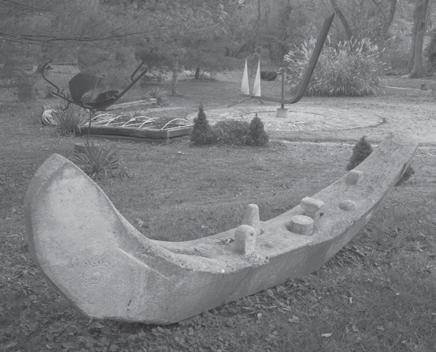
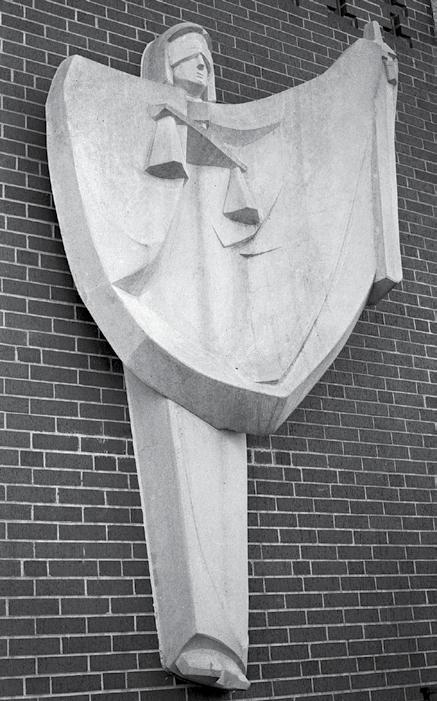 Photo courtesy of Blake Justice
Canoe I, Date unknown | Cast concrete
Photo courtesy of Blake Justice
Photo courtesy of Blake Justice
Canoe I, Date unknown | Cast concrete
Photo courtesy of Blake Justice
many creative directions that Robert has taken in his artistic career. His ambition to be an artist began in the third grade. He very much admired one fellow student’s ability to draw and from that time on, art was Robert’s focus. His mother, Opal, discerning Robert’s propensity for art and his curiosity about the world, purchased something quite extravagant in the time of the Great Depression. She bought him what served as his first “studio,” a Chautauqua Industrial Art Desk. It had a matching stool that was adjustable for a growing boy and the top was a drawing surface with a black board on the other side. Thus began Robert’s long love affair with art.


Here you see 76 years of one remarkable man’s engagement with, love for, and pleasure in this cultural phenomenon we call art. Robert is a man who has imbued his joy for life in these physical objects, in which, with an open mind and heart, we may find pleasure as well.

JAY NELSON
Jay Nelson is an art curator and former owner and director of the Strecker Nelson Gallery. Curatorial and collection projects include those for the Kansas Masters Biennial traveling exhibit, Flint Hills Masters for The Flint Hills Discovery Center, Art Kansas for McPherson College, and the Meadowlark Hills Art Collection in Manhattan, Kansas. He was a Kansas Arts Commissioner and served as chairman of the Manhattan Arts & Humanities Board, as well as president of The Friends of the Beach Museum. With his wife Barbara, he received the 2008 “Kansas Governor’s Award” from Kathleen Sebelius for arts advocacy.
Photo by Jay Nelson
Archaic Fish, 2016 | Oil on board Image courtesy of Chad Graff & Joann Falkenburg
Geologica III, 2012 | Oil on board Image courtesy of Jay & Barbara Nelson
ROBERT BLUNK
by Stephanie Jackson-Dillon | Permission
Robert Blunk is a distinguished artist of note in the Midwest. His work is in the permanent collection of many museums, including Spencer Museum of Art, Lawrence, Kansas; Hale Library, Manhattan, Kansas; Schingoethe Center, Aurora, Illinois; Marianna Kistler Beach Museum of Art at Kansas State University, Manhattan, Kansas; and New England Foundation for the Arts in Boston, Massachusetts. Blunk’s work also forms the centerpiece of public arts projects in several cities in Kansas and is well-loved by many private collectors.
Robert Blunk was born in 1923 in Salyards, Kansas. After serving in the Pacific with the Marine Corps in World War II, he returned home to Kansas and earned a Bachelor of Fine Arts at Kansas City Institute of the Arts in 1950. He later earned a Master of Fine Arts (sculpture) at Pittsburg State University, Pittsburg, Kansas, and worked toward his doctorate at the University of New Mexico, Albuquerque, New Mexico. For over 40 years, he had a notable teaching career combined with an active career creating public sculpture, designs and installations.
In addition to this impressive public profile, Blunk painted and made sculpture in his studio. As with any artist, his style evolved over the years. There are themes that resurface throughout his work—both in paintings and sculpture.
A consistent exploration of space and color is evidenced in both his twodimensional and three-dimensional work. Blunk is drawn to seascapes and
 to reprint from the Blunk family
Photo courtesy of Alysh Lynch
to reprint from the Blunk family
Photo courtesy of Alysh Lynch
landscapes and permutations of the two, figurative and abstract. He also paints still lifes and interiors. A spiritual element permeates pieces. For example, in one instance, a trip to Puerto Rico resulted in an assemblage with a heraldic angel. His interests—as far ranging as Egyptian art to the Wright Brothers—earn witty or overt reference in his work.

Of his many works, especially interesting is a series of carved, extruded clay sculptures undertaken as a result of a propitious encounter with one of his college students who worked as a supervisor at an industrial pipe factory. Blunk visited the place and, afterwards, anticipating a sabbatical from teaching the following year, he proposed a fellowship—a first of its kind—at the factory to work with the extruded clay. The result was a significant body of sculptures that are consistently compelling yet range in mood from whimsical to solemn. That whimsy is also evident in a series of welded metal ship sculptures that also incorporate found objects and extends to other, more abstract, found-object pieces.
In 2014, a portfolio of eight images (in an edition of 24) representative of various periods of his career (dates of included works range from 19482013), was printed by Profiles, a print studio in Philadelphia, PA. In 2016 and 2017 Blunk exhibited at the Chestnut Hill Gallery in Philadelphia. In 2018 he had a one man exhibit from which all proceeds were donated to benefit Tyler School of Art’s ArtStart Program.
His current work of miniature, painted still lifes and interiors, reflect his vibrant sense of color, energetic drawing style and unerring graphic sensibility. These small paintings represent some of the strongest oeuvre in a remarkable career.
Blunk admires the works of artists ranging from Alexander Calder to David Smith and George Nakashima, and from Paul Klee, Van Gogh and Marsden Hartley to outsider artists.
Robert Blunk’s talents, tastes and interests are broad, but his vision is singularly his own. At age 99, Bob continues to make art at his home studio in Denver, Colorado.
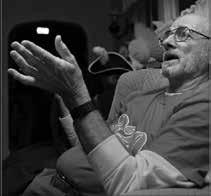

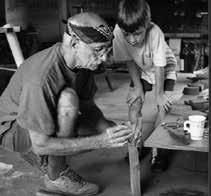
ROBERT BLUNK
LEAD ARTWORK
Americana, 1987
Mixed media construction, found objects
82 x 48 inches
On loan courtesy of the Marianna Kistler Beach Museum of Art, Kansas State University
THE FISH
Untitled sketches from Kansas City Art Institute
sketchbooks, 1947-48
Reproductions
Size variable
On loan courtesy of the Marianna Kistler Beach Museum of Art, Kansas State University
Fish on a Rope, 1948
Lithograph
11 x 13 inches
On loan courtesy of the Marianna Kistler Beach Museum of Art, Kansas State University
Three White Fish, 1968
Oil on canvas
26 x 28 inches
On loan courtesy of the Marianna Kistler Beach Museum of Art, Kansas State University
Four Fish, 2011
Oil on board
24 x 24 inches
On loan from the collection of Jay & Barbara Nelson
Black Fish, 2015
Oil on board
10 x 10 inches
On loan from the collection of Chad Graff & Joann Falkenburg
Archaic Fish, 2016
Oil on board
10 x 10 inches
On loan from the collection of Chad Graff & Joann Falkenburg
Title unknown (female figure study), 1947
Charcoal on paper
18 x 24.25 inches
On loan courtesy of the Marianna Kistler Beach Museum of Art, Kansas State University
THE FISHERMEN
Big Fisherman, 1948
Lithograph
12 x 10 inches
On loan courtesy of the Marianna Kistler Beach Museum of Art, Kansas State University
Isaiah, 2010
Gouache
16 x 12 inches
On loan from the artist
Joshua, 2010
Gouache
16 x 12 inches
On loan from the artist
Zeke, 2010
Gouache
16 x 12 inches
On loan from the artist
Darrell with Fish, 2010
Gouache
15 x 11 inches
On loan from the collection of Chad Graff & Joann Falkenburg
Far North, 2022
Enamel on board
20 x 23 inches
On loan from the collection of Chad Graff & Joann Falkenburg
Phishermen, 2023
Enamel on board
24 x 30 inches
On loan from the collection of Chad Graff & Joann Falkenburg
Boy with Boat, Undated Wood with polychrome
48 x 24 inches
On loan from the collection of Chad Graff & Joann Falkenburg
THE MAINE COASTAL VILLAGE
Grey’s Cove, 20th century Polychrome wooden collage 40 x 36 inches
On loan from the collection of Chad Graff & Joann Falkenburg
Patchwork, 2023
Enamel 24 x 24 inches
On loan from the collection of Chad Graff & Joann Falkenburg
THE BOATS
Wives of Fishermen, 1948
Lithograph
11.5 x 13.5 inches
On loan courtesy of the Marianna Kistler Beach Museum of Art, Kansas State University
Title unknown (two men in sail boat), 1948
Lithograph
8.5 x 12 inches
On loan courtesy of the Marianna Kistler Beach Museum of Art, Kansas State University
Beached Boats, diptych, ca. 2012
Oil on canvas
29 x 144 inches
On loan from the collection of Chad Graff & Joann Falkenburg
The Becca Tamar Out of Boston, Undated Various found metal objects
42 x 76 inches
On loan from the collection of Bill & Kathleen Pierson
Up the Zambezi River, 1960
Extruded clay
11.5 x 18 x 4.25 inches
On loan from the artist
Continued
Square Rigger, 1960
Extruded clay
34 x 18 x 4 inches
On loan courtesy of the Marianna Kistler Beach Museum of Art, Kansas State University
INTERIORS AND FURNISHINGS
Untitled sketches from Kansas City Art Institute
sketchbooks, 1947-48
Reproductions
Size variable
On loan courtesy of the Marianna Kistler Beach Museum of Art, Kansas State University
Independence Avenue
Recreation Parlor, 1948
Lithograph
6 x 8 inches
On loan courtesy of the Marianna Kistler Beach Museum of Art, Kansas State University
Title unknown (“Honey
Chile” pool hall), ca. 1949
Oil on canvas
52 x 40 inches
On loan from Scott Blunk
Title unknown (overhead
view of pool parlor), ca. 1949
Oil on canvas
52 x 40 inches
On loan from Scott Blunk
Bouquet, 2015
Oil pen on board
6 x 6 inches
On loan from the collection of Jay & Barbara Nelson
Boats and Jugs, 2015
Oil pen on board
6 x 6 inches
On loan from the collection of Jay & Barbara Nelson
Skillet and Two Eggs
Over Easy, 2015
Oil pen on board
6 x 6 inches
On loan from the collection of Jay & Barbara Nelson
White Floor and Black Fish, 2015
Oil pen on board
6 x 6 inches
On loan from the collection of Jay & Barbara Nelson
Still Life Kit I, ca. 2020
Oil on board
6 x 6 inches
On loan from the collection of Chad Graff & Joann Falkenburg
Still Life Kit II, ca. 2020
Oil on board
6.25 x 6 inches
On loan from the collection of Chad Graff & Joann Falkenburg
Studio Fragments, 2020s
Collage and mixed media
24 x 24 inches
On loan from the collection of Chad Graff & Joann Falkenburg
PLACES SACRED AND DOMESTIC
Rachel and the Angels, 1982
Oil on board
47.5 x 35.5 inches
Courtesy Spencer Museum of Art, University of Kansas, Gift of the family of Katherine & Robert Blunk, 2010.0191
White Room with Lady and Cat, 2019
Enamel
16 x 20 inches
On loan from the collection of Chad Graff & Joann Falkenburg
Night in the Orange House, 20th century Oil
20 x 24 inches
On loan courtesy of the Marianna Kistler Beach Museum of Art, Kansas State University
Iglesia, 2015 Oil
10 x 10 inches
On loan from the collection of Chad Graff & Joann Falkenburg
Geologica I, 2008
Oil on board
23 x 23 inches
On loan from the collection of Chad Graff & Joann Falkenburg
Geologica III, 2012
Oil on board
22 x 22 inches
On loan from the collection of Jay & Barbara Nelson
House Study, Morning Work, 2022
Enamel
24 x 24 inches
On loan from the collection of Chad Graff & Joann Falkenburg
A Good Day, 2020 Oil
24 x 24 inches
On loan from the collection of Chad Graff & Joann Falkenburg
In the Time of Coronavirus, 2020 Oil
24 x 24 inches
On loan from the collection of Chad Graff & Joann Falkenburg
ABSTRACTIONS
‘Otel, 20th century Oil
10 x 10 inches
On loan from the collection of Chad Graff & Joann Falkenburg
Laundry Sky, 2015 Oil
10 x 10 inches
On loan from the collection of Chad Graff & Joann Falkenburg
Abstract Pears, 2012
Oil
10 x 10 inches
On loan from the collection of Chad Graff & Joann Falkenburg
Pink Hulled Boat, 2015
Paint stained textile from the artist’s painting pants, pink toweling fabric, oil and enamel on board
24 x 24 inches
On loan from the collection of Chad Graff & Joann Falkenburg
Shapes II, 1958
Oil
28 x 40 inches
On loan courtesy of the Marianna Kistler Beach Museum of Art, Kansas State University
Xebec, 1960
Welded metal
27 x 23.5 x 35 inches
On loan courtesy of the Marianna Kistler Beach Museum of Art, Kansas State University
Sail Boat and Fish, 2016
Mixed media collage
24 x 24 inches
On loan from the collection of Chad Graff & Joann Falkenburg
THE NON-OBJECTIVE PAINTINGS
Study of Rectangles, 2022
Enamel
24 x 24 inches
On loan from the collection of Chad Graff & Joann Falkenburg
Mostly Rectangles, 2022
Mixed media with enamel
24 x 24 inches
On loan from the collection of Chad Graff & Joann Falkenburg
A Study in Black, Rectangle, 2021
Enamel
24 x 24 inches
On loan from the collection of Chad Graff & Joann Falkenburg
Etaoin Shrdlu, 2022
Enamel
24 x 24 inches
On loan from the collection of Chad Graff & Joann Falkenburg
EXHIBITION PROGRAMMING
OPENING RECEPTION
Thursday, September 21 5-7 pm
Salina Art Center
Remarks by Guest Curator Jay Nelson at 6pm
ART BYTE
Wednesday, October 18 12:15-12:45pm
Salina Art Center FREE
WRITING WITH ART: Found Along the Shore with Lori Brack
Saturday, October 14 10:30am-Noon
Salina Art Center
$35
CREDITS
Catalog published by Salina Art Center to accompany the exhibition
Robert Blunk: Found Along the Shore
September 20-October 29, 2023
Salina Art Center
242 S. Santa Fe Ave. Salina, Kansas 67401
Curated by Jay Nelson
Catalog essay by Jay Nelson
Robert Blunk bio by Stephanie Jackson-Dillon, used with permission of the Blunk family
Video courtesy of Alysh Lynch
Installation by Daniel Picking & Jay Nelson
Catalog design by Pamela Harris
Scan to sign the virtual guest book and take a survey.

Creating exchanges among art, artists, and audiences
Founded in 1978, the Salina Art Center is a 501(c)3 creating exchanges among art, artists, and audiences that reveal life. Accredited by the American Alliance of Museums, the Art Center’s galleries, Art Center Cinema, and Warehouse are located in the heart of downtown Salina, Kansas. Learn more online at www.salinaartcenter.org. The Salina Art Center’s exhibitions and programs are funded by Art Center donors and members, grants,foundations, business partners, and the City of Salina.
Salina Art Center museum admission is always free to everyone. Members, donors, business partners, foundations, the Salina Art Center Endowment Foundation, and the City of Salina provide critical funding for exceptional experiences around viewing, discussing, and making art.
Learn how you can live a more creative life by becoming a Salina Art Center member, and how your gifts keep quality art experiences accessible to everyone.
Visit us online at www.salinaartcenter.org.




Follow us on social! @SalinaArtCenter Scan to get SAC updates by text!






 Rachel and the Angels, 1982 | Oil Image courtesy of Spencer Museum of Art, University of Kansas
White Room with Lady and Cat, 2019 | Enamel Image courtesy of Chad Graff & Joann Falkenburg
Rachel and the Angels, 1982 | Oil Image courtesy of Spencer Museum of Art, University of Kansas
White Room with Lady and Cat, 2019 | Enamel Image courtesy of Chad Graff & Joann Falkenburg

 Bob in his self-made “roach”
Photo by Patrick Lofthouse
Image courtesy of Marianna Kistler Beach Museum of Art, Kansas State University
Bob in his self-made “roach”
Photo by Patrick Lofthouse
Image courtesy of Marianna Kistler Beach Museum of Art, Kansas State University

 Ship of Fools, 2020 | Metal Image courtesy of Chad Graff & Joann Falkenburg
The Becca Tamar Out of Boston Mass, Undated | Various found metal objects Image courtesy of Bill & Kathleen Pierson
Ship of Fools, 2020 | Metal Image courtesy of Chad Graff & Joann Falkenburg
The Becca Tamar Out of Boston Mass, Undated | Various found metal objects Image courtesy of Bill & Kathleen Pierson

 Photo courtesy of Blake Justice
Canoe I, Date unknown | Cast concrete
Photo courtesy of Blake Justice
Photo courtesy of Blake Justice
Canoe I, Date unknown | Cast concrete
Photo courtesy of Blake Justice



 to reprint from the Blunk family
Photo courtesy of Alysh Lynch
to reprint from the Blunk family
Photo courtesy of Alysh Lynch






